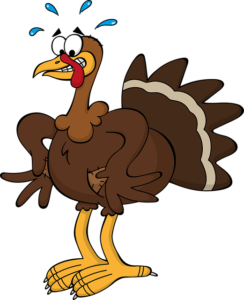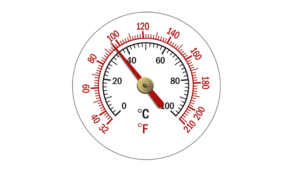Are you thinking of deep-frying turkey for the next big holiday? The main question that most of us ask ourselves before preparing a turkey is the time it takes to deep fry such a big bird. A deep-frying turkey time chart will be really helpful in figuring that out. So, how long does it take? Is deep frying faster than using an oven?
Temperature and time are the main factors you have to focus on if you want to have a perfect turkey for your family. In this post, we intend to help you cook a perfect turkey for your family. We have compiled some details to help you cook like a professional. This post also features a deep-frying turkey time chart.
We will give different times for different sizes of turkey and different temperatures. Stay tuned for further details.
Considering the Weight
When you are planning to deep fry a turkey, you should consider two main, very important factors. The first is the weight of the turkey and the second is the temperature at which you are deep-frying the bird.
The first recommendation is to deep-fry your turkey at around 350 degrees Fahrenheit. If you use temperatures that are lower than 350 degrees Fahrenheit, you will have a hard time cooking the bird properly. So, how many minutes per pound to fry a turkey? Well, we highly recommend that you deep fry a turkey for 3 minutes for each pound if it weighs 14 pounds or smaller. On the other hand, the turkey fryer times per pound for a bird that is larger than or equal to 15 pounds is 3 ½ minutes for each pound.
The Time Chart
This section features a turkey frying time chart that will help you quickly identify the amount of time you should take to deep fry a certain size of turkey.
| Size of Turkey Weight in Pounds | Time to Deep Fry in Minutes (At 350 Degrees Fahrenheit) |
|---|---|
| 24 Pounds | 1 Hour and 24 Minutes (84 Minutes) |
| 23 Pounds | 1 Hour and 20 ½ Minutes (80 ½ Minutes) |
| 22 Pounds | 1 Hour and 17 Minutes (77 Minutes) |
| 21 Pounds | 1 Hour and 13 ½ Minutes (73 ½ Minutes) |
| 20 Pounds | 1 Hour and 10 Minutes (70 Minutes) |
| 19 Pounds | 1 Hour and 6 ½ Minutes (66 ½ Minutes) |
| 18 Pounds | 1 Hour and 3 Minutes (63 Minutes) |
| 17 Pounds | 59 ½ Minutes |
| 16 Pounds | 56 Minutes |
| 15 Pounds | 52 ½ Minutes |
| 14 Pounds | 42 Minutes |
| 13 Pounds | 39 Minutes |
| 12 Pounds | 36 Minutes |
| 11 Pounds | 33 Minutes |
| 10 Pounds | 30 Minutes |
This will be fully determined by the deep fryer. If you want to determine if the turkey has cooked properly, consider the temperature of the turkey. The dark meat of the turkey should be at a minimum of 350 degrees Fahrenheit. The white meat, on the other hand, should be at 165 degrees Fahrenheit.
If the meat is at that temperature, then it might just be ready to serve and enjoy.
Considering the Temperature
Now, let us look at the different temperatures at which you can cook the turkey.
At Temperatures between 250 and 300 Degrees Fahrenheit
As we mentioned earlier in the post, we do not recommend that you deep fry your turkey at any temperatures that are below 350 degrees Fahrenheit. The reason? Well, the oil will most likely soak too much in the turkey. When that happens, it will be extremely hard to heat the turkey properly internally. 350 degrees Fahrenheit is the adequate temperature with the times specified in the time chart.
At 400 Degrees Fahrenheit
At 400 degrees, you would expect the turkey will take less time to cook. It is plausible to deep fry your turkey at this temperature. However, if you want to do that, we highly recommend that you keep a close eye on the turkey, making sure that it will not burn due to the high temperature. If you overcook it, you could mess up everything.
Using an Electric Fryer
The time of cooking should not change because of the appliance you want to use to fry the chicken. You can use an electric fryer if you want.
The only thing you need to do is ensure that the turkey submerges the whole time it is cooking. Additionally, you should ensure that the temperature you are cooking at will remain constant and does not drop at any point. If you manage to keep these at a constant, then the turkey should cook just fine regardless of the appliance you are using to cook your turkey.
Safety
You need to be safe when you are cooking your turkey. That means avoiding any fire or oil spilling.
- Take steps such as ensuring that the turkey thaws completely before you deep fry it.
- Deep fry the turkey before you can stuff it.
- Avoid overfilling the fryer.
- Avoid overheating the oil.
- Ensure you place the fryer on a flat surface.
Read:
FAQs
-
When should you inject a turkey before frying it?
In general, you should inject your turkey with marinade for at least 30 minutes before cooking. This will give the marinade time to penetrate the meat and flavor it throughout. If you’re using a marinade with ingredients like garlic or onion, you may want to give it even more time to work its magic. Injecting the turkey the night before you plan to cook it will give the flavors plenty of time to develop.
-
Can you overcook a deep-fried turkey?
Deep frying a turkey is a popular cooking method during the holidays. However, many people are unsure of how to properly deep fry a turkey and often overcook it. This can lead to a dry, overcooked turkey that is not very enjoyable to eat.
There are a few things that you can do to avoid overcooking your turkey. First, make sure that you have a reliable thermometer to check the internal temperature of the turkey. The internal temperature of the turkey.
Another tip to avoid overcooking your turkey is to not overcrowd the fryer. If there are too many turkeys in the fryer, they will not cook evenly and some will be overcooked while others are not cooked enough. Make sure to follow the manufacturer’s instructions on how many turkeys can be fried at one time.
Finally, be sure to keep an eye on the turkey while it is frying. Overcooking can occur quickly, so it is important to check on the turkey frequently. If the turkey is getting too dark, you can reduce the heat of the fryer.
By following these tips, you can avoid overcooking your turkey and ensure that it is cooked properly. Enjoy your holiday meal!
-
What oil is best for deep frying turkey?
The best oil for deep frying turkey is one that has a high smoke point. This means that the oil can be heated to a high temperature without smoking or burning.
Good choices for high smoke point oils include peanut oil, soybean, sesame seed, grapeseed, canola oil, and vegetable oil. When choosing an oil for frying, you’ll also want to consider the flavor. (Take a look at these cooking oil mixes)
Some oils, like olive oil, can add a distinct flavor to your turkey. If you’re looking for a neutral-tasting oil, opt for one of the oils listed above.
Finally, consider the cost of the oil when making your decision. Some oils, like peanut oil, can be quite expensive. If you’re on a budget, consider using a less expensive oil like canola oil.
More important notes:
Safety Precautions
Ensuring safety during deep-frying is paramount. Always set up the fryer outdoors, away from structures, and use it on a flat, stable surface. Keep a fire extinguisher nearby and never leave the fryer unattended. Wearing protective gear, such as gloves and eye protection, is crucial to prevent accidents.
Choosing the Right Turkey
Selecting the right turkey is the first step to a successful deep-frying experience. Opt for a bird between 10 to 14 pounds for optimal results. Thaw the turkey completely and pat it dry to avoid oil splatter.
Selecting the Right Deep Fryer
Various types of deep fryers are available, from propane models to electric versions. Consider factors like capacity, safety features, and ease of cleaning when choosing the right fryer for your needs.
Ingredients and Marinades
Enhance the flavor of your deep-fried turkey with the right seasonings and marinades. From Cajun spices to herb-infused blends, experimenting with different flavors can elevate your culinary creation.
Setting Up the Deep Fryer
Assemble the fryer according to the manufacturer’s instructions. Fill it with the recommended amount of oil and preheat to the desired temperature, usually around 350°F. Use a reliable thermometer to monitor the oil’s heat.
Deep Frying Process
Refer to our handy time chart for deep-frying turkey based on weight. A general rule is about 3 to 4 minutes per pound. Ensure the turkey reaches an internal temperature of 165°F for safe consumption.
Common Mistakes to Avoid
Avoid overfilling the fryer, as hot oil can overflow and cause a fire. Maintain the correct oil temperature to achieve a crispy exterior without burning. Never attempt to deep-fry a frozen turkey, as this can lead to dangerous situations.
Troubleshooting Tips
Encounter issues during deep-frying? Check our troubleshooting tips for solutions. From uneven cooking to oil temperature fluctuations, we’ve got you covered for a hassle-free experience.
Benefits of Deep-Frying
The magic of deep-frying lies in its ability to deliver a turkey with a perfect balance of crispy skin and juicy meat. Additionally, deep-frying is a time-efficient cooking method compared to traditional roasting.
Alternative Cooking Methods
While deep-frying is popular, explore alternative methods like oven-roasting and grilling. Each method has its pros and cons, allowing you to choose the one that best suits your preferences and available equipment.
Cleaning and Storing the Deep Fryer
Proper maintenance ensures the longevity of your deep fryer. Clean it thoroughly after each use, and store it in a cool, dry place. Regular maintenance prevents oil residue buildup and extends the life of your equipment.
Environmental Impact
Consider the environmental impact of deep-frying. Properly dispose of used oil and explore eco-friendly practices, such as recycling oil for other purposes. Being mindful of the environment adds a responsible touch to your culinary endeavors.
Popular Deep-Fried Turkey Recipes
Explore unique recipes for marinades and rubs to infuse your deep-fried turkey with irresistible flavors. From citrus-infused blends to spicy concoctions, there’s a recipe for every taste.
Conclusion
A turkey is a great meal to serve your family and friends regardless of the size of the group, especially during the holidays. Deep frying is a great way of making sure that the juicy flavors are maintained. If it is your first time deep-frying the turkey, ensure that you follow the recipe properly and you use adequate time.
Also, read:
- Best Indoor Turkey Fryer Reviews
- Best Turkey Roasting Pans with Lids
- How To Deep Fry in a Non-Stick Pan
Feel free to share your observations with me in the comments section!
Also, if you find the information in this post to be useful, be sure to share this post with your friends on Facebook, Twitter, and Pinterest!







